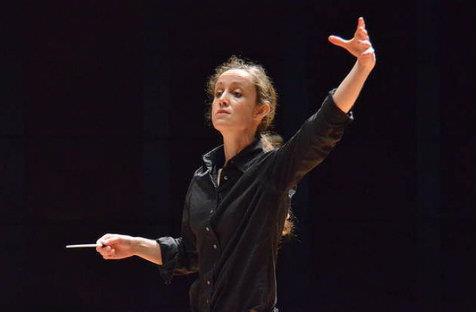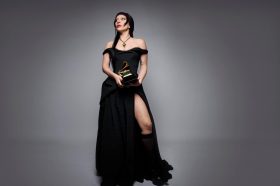The Sydney Symphony, it must be said, seem to be struggling to understand what the idea of their ‘Mozart Mystery Moment’ is. In their four– concert series at the City Recital Hall – concerts without an interval, and thus running anywhere between 60 to 90 minutes – they have, at the end, a small and secret piece, something to make the audience lean over to their partners and whisper ‘is it…?’, or ‘I think I know…’, or ‘why is everyone whispering…?’. It acts, basically, as an encore, although it is programmed in, and the identity of the piece is only revealed the next day on Twitter. What saddens this critic is that thrice in recent memory, including the very evening under question, these Mystery Moments have been, to say the least, not exactly spot-on when sticking to their mission statement.
The first concert, for instance, didn’t have a Mozart Mystery Moment at all – or rather, a mysterious moment that came about precisely because there was no mysterious moment. In another, the conductor blithely announced the piece before they began, taking the all the mystery and laying it out for bare autopsy. And at this concert – Mozart’s Jupiter Symphony – the problem cropped up again. ’Wait,’ I thought to myself, as the piece got underway. ’That doesn’t sound like Mozart. That doesn’t sound like Mozart at all.’ And it wasn’t. Rather, it was Swiss composer Arthur Honegger’s Pastorale d’ete. This seems somewhat disingenuous to me, like sending kids on an Easter Egg Hunt but failing to tell them they should be looking for bananas. Still, the piece was an extremely pleasant five or 10 minutes, so one can’t complain all that much. (Much as one tries to.)
There were three other pieces on the program for the evening, all of them properly documented and with passports in hand. The first, Mozart’s The Magic Flute: Overture, was the best of the lot. Jessica Cottis, the Sydney Symphony’s new assistant conductor, did the honours. She is – and what a dismal statistic this is – only the third woman I’ve seen conduct. Baton free and hands akimbo, she conducts enthusiastically but with a slight reserve; this audience member felt that she knew what she wanted and when and how to get it. She certainly got, for instance, a wonderful and loud sound out of the brass, which made the Overture shine, as well as a great sense of pace and sizzle from the strings. A good test for an overture is whether you want to see the opera after the concert has finished, and such was the case with this.
A world premiere followed – one of three in three weeks for the Sydney Symphony (the first being John Adams’ saxophone concerto last week, the third a piece of Nigel Westlake, composer of the glorious Missa Solis heard last year, at a concert this week). It is by a composer one was entirely ignorant of, Mary Finsterer, Australian and acclaimed, according to the program, as one of our ‘most original composers’. Her piece, for which she was in attendance, was entitled Lake Ice – Double Bass Concerto, with Kees Boersma, principal double bass of the Symphony, taking centre stage. (There was a speaker behind the conductor’s podium facing towards the audience – a speaker that is not usually there – so perhaps the double bass was amplified somewhat, but one cannot be sure. (ABC was recording the concert, so there were microphones everywhere.)
The piece begins with bows sawing on the same note, first the double bass, and then the rest of them joining in, with constant pauses in between each one or two second flurry. It builds from there with a slight tinge of American Noir (although a tad more enchanted), before transferring into a middle section that’s dotted with a sort of Cubanesque drums behind a whirring, forceful collection of energies. It was this middle section where I think the piece faltered somewhat, as one felt that something was being built up to, but we never quite got to that point where the music completely fills the ears (like it did, for example, with the brass in the previous Overture). Perhaps on a second listen, one might find this not a problem at all, but on first contact it was. The piece then moves back into its initial flurrying territory before coming to a halt. From the program: ‘‘Lake Ice’ refers to Norse mythology, Finsterer explains: From Yggdrasill, an immense tree central to the structure of the universe, nine worlds branch out. The penultimate world, Niflhel, is made of ice and mist. Here creation began, a place where lakes of ice mixed with heat to form a creating stream. Lake Ice evokes a legendary landscape of primordial cold, when earth was shaped by pagan Gods.’ It was an absorbing piece – but a bit less so as the middle portion kept on and on – and Boersma was a confident and charismatic soloist on an instrument that, apart from the Symphony’s more jazz concerts, rarely sees the middle of the platform. One certainly gets the sense of ice from the music, and colours of cracked stillness.
Mozart’s Symphony No.41 in C, K551 (Jupiter) was the third piece on offer, and Cottis provided a more than satisfactory account, even if she didn’t quite reach the heights of the overture. The second, slow movement was one highlight, while the fugal moments in the last were notable for their clarity and control. These Mozart in the City concerts are always a good choice for a classical music fan, and this one was no exception.
Rating: 4 stars out of 5
Mozart’s Jupiter Symphony
Sydney Symphony
Jessica Cottis (conductor), Kees Boersma (double bass)
Wolfgang Amadeus Mozart – The Magic Flute: Overture
Mary Finsterer – Lake Ice – Double Bass Concerto
Wolfgang Amadeus Mozart – Symphony No.41 in C, K551 (Jupiter)
Arthur Honegger – Pastorale d’ete
City Recital Hall, Sydney
29 August
(Pictured: Conductor Jessica Cottis)




